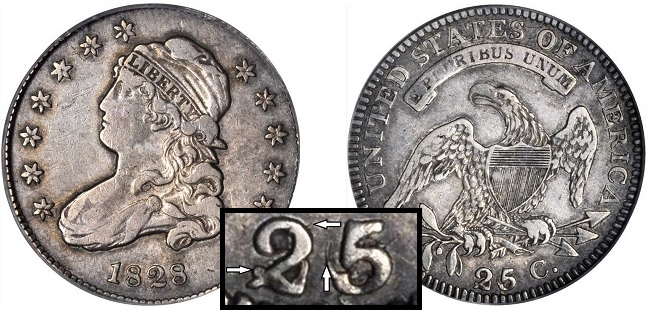1828 Capped Bust Quarter, 25/50 C.
When the United States Mint was established in 1792, it lacked machinery, materials, and proper funding for coining operations. The new Mint facility in Philadelphia, the first federal building commissioned under the Constitution, provided woefully inadequate floor space to manufacture the nation’s coins.(1)
One of the most serious problems facing the new Mint was acquiring good quality steel from which to forge its dies. The metal arrived in the form of cast bars. From there, many laborious steps were required to produce working dies. Frequently, a die cracked or shattered during the process if the steel was not of the optimal fineness.
After a working die was placed into service, die cracks and breaks often occurred prematurely. Serious collectors of early die varieties are well familiar with these flaws. The challenge of keeping on hand useable dies explains the Mint’s reluctance to dispose of these dies, even if they were less than perfect.
One die marriage of the 1822 Capped Bust quarter featured an obviously blundered reverse die, where 25 was punched over 50. The goof occurred when the inattentive engraver thought he was working on a half dollar and punched a “5” and a “0” into the bottom of the reverse. When the error was noticed, he (sort of) corrected the mistake by punching a "2" over the "5" and a "5" over the "0.(2) The die was then employed as the reverse of the famous 1822 25/50C quarter.
Because the blundered 25/50 reverse die was still capable of making good coins at the end of the 1822 run, it was put into storage.
Six years later, in 1828, in spite of its error, the now rusted die(3) was pressed into service once again. The 1828 25/50C is yet another intriguing die variety of the Capped Bust quarter series, and is the rarest among the quarters of 1828.(4)
While the 1828 25/50C quarter generally receives less attention than its older half-brother, the 1822 25/50C, it has chugged along very nicely in price appreciation, as illustrated by a beautiful stairstep bar chart pattern (see charts below). This is to be expected for a truly rare coin matched against steady collector demand.
| Estimated survivors in all grades: 87 ?
The survivor estimate from PCGS represents an average of one or more experts' opinions as to how many examples survive of a particular coin in all grades. Survival estimates include coins that are raw, certified by PCGS, and certified by other grading services. Learn more at PCGS. |
| PCGS Rarity Scale: 8.1 ?
The 'PCGS CoinFacts Rarity Scale' assesses the relative rarity of all U.S. coins, based on estimated surviving examples. The scale runs from 1.0 to 10.0. The higher the number, the rarer the coin.
Learn more at PCGS. |
| Click HERE to check for availability on eBay** |
Preview of eBay selection (sometimes the HERE link above works better than the Preview):
 |
|
| Trendline Avg = 19.89 | BETTER |
Historic Value Trend Charts:
| Last updated 4-8-25 | Return to Key Date Coin List | |
| Compare to Common Date Coin of Same Type | ||
|
|
||
| Download Charts to Your Computer | ||
Sources
1. Taxay, Don. The U.S. Mint and Coinage. New York, NY: Sanford J. Durst Numismatic Publications, 1966.
2. PCGS. 1828 25C 25/50C (Regular Strike).
3. NGC. 1828 25C MS.
4. Stack's Bowers Galleries. 1828 Capped Bust Quarter 25/50C. May 2015 Auction.
**Many very fine coin dealers sell on eBay. At any point in time, there may be over one million search results for United States coins. This includes quite a few of the recommendations on our Key Date Coin List.
If you’re thinking about purchasing a rare coin, eBay is certainly worth a look. For your convenience, the links from this site to eBay are coded to bring up only coins certified by PCGS and NGC.
As is always, always the case, never buy a valuable coin from a seller whose trustworthiness cannot be verified. Learn more about this at our chapter Best Places to Buy Coins, which also has a section on doing business on eBay.
In the interest of full disclosure, Rare Coins 101 receives a small commission anytime someone connects to eBay from this site and purchases something.
Coin images by Stack's Bowers Galleries.


